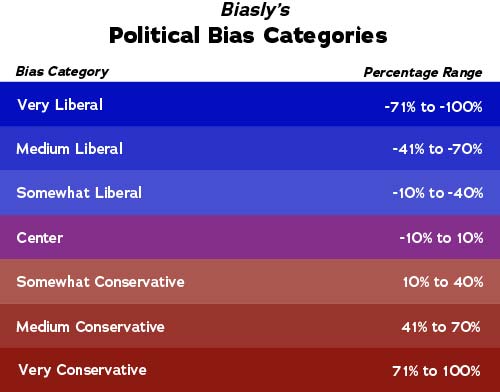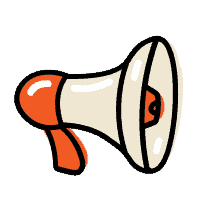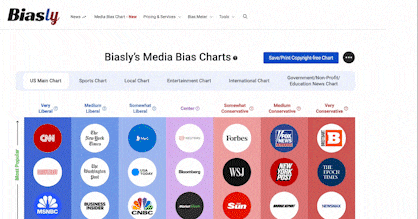
At Biasly, we categorize political bias on our Bias Meter into nine distinct categories along a spectrum. Knowing and understanding your own biases will enhance your critical thinking anytime you come across information that may be biased and inaccurate. Sometimes we may perceive objective information as skewed towards one side because of our own biases or vice versa.
One way to better understand your own biases and political leanings is taking Biasly’s Political Bias Survey. It provides people with a bias score and category which they align with most, and where they line up on the spectrum. Biasly asks participants where they stand on a variety of issues with multiple answers (e.g., What role should the federal government play in healthcare?), and provides a score at the end. The scores on the spectrum range from -36 to 36, with -36 being the most Left and 36 being the most Right. These surveys ranges are different than our Bias Meter’s categories as shown below.
Bias Categories and Definitions
The bias categories from left to right are: Very Left, Medium Left, Somewhat Left, Center, Somewhat Right, Medium Right, and Very Right. We define each of these categories in the sections below.
| Bias Category | Percentage Range |
| Very Left | -71% to -100% |
| Medium Left | -41% to -70% |
| Somewhat Left | -10% to -40% |
| Center | -10% to 10% |
| Somewhat Right | 10% to 40% |
| Medium Right | 41% to 70% |
| Very Right | 71% to 100% |
Very Left
This is the most left-wing ideology on the spectrum. People who are very or extremely Left hold the most left-wing position on nearly all or all topics. They usually advocate for ambitious, immediate, and drastic government intervention to solve the pressing issues of the day.
“We must immediately act to transition away from fossil fuels if we want to prevent climate catastrophe. The future of the planet is at stake!”
“We must dismantle systems of economic oppression and privilege, and build a world where everyone can have full equality.”
“The government must raise taxes on billionaires and use the money to provide free healthcare and give to the poor.”
“It is incumbent that the federal government passes a new voting rights bill to end voter suppression. We must strengthen our democracy to prevent politicians from overriding the will of the people.
Both quotes indicate drastic and end-of-the-spectrum ideological leanings. They speak to a desire to dismantle the status quo. Incremental change isn’t good enough to achieve the ultimate goal.
Medium Left
The largest group on the left side of the spectrum are Medium Lefts. Whereas people who are Very Left are passionate and feel strongly about their stances, the Medium Left group tends to be in the medium or mainstream of the Democrat party. Therefore, they tend to support most of the mainstay ideologies that the Democrat party is for. They don’t support extreme policy but mostly stick with more reasonable approaches in the policy leanings.
“We need to work on reducing income inequality in this country. Raising taxes on the wealthy could generate revenue to strengthen social programs for the poor.”
“We must prioritize comprehensive reform that provides a pathway to citizenship for undocumented immigrants and provide support for them along the way.”
Medium Lefts may hold similar positions to people further to their left but use a more reasonable, but firm tone. A reasonable but firm tone can better help build coalitions to win support and pass their agenda, while staying more firm on core principles of the party.
Somewhat Left
When someone is Somewhat Left, most of their views slightly lean left but they may hold limited Right positions. Below are two examples of left-leaning positions with a moderate tone.
“I think we should consider reforming our immigration policies to allow some easier pathways to citizenship. Deporting all undocumented immigrants seems impractical.”
“While I believe that women have a right to an abortion, I do believe in restrictions past the point of viability unless the mother’s life is at risk.”
The first quote expressed openness to reforming the immigration system and providing a pathway from citizenship for the undocumented population. The second states a preference for legal abortion with some restrictions. These are Left positions, but the more moderate tone keeps them from being Medium Left. Overall, this group is sometimes the least politically engaged group and the least likely to show strong support for the Democratic Party from those on the left.
Center
People who identify as moderate hold views that split pretty evenly between Left and Right topics. They are less likely to identify with either major political party compared to individuals who lean Left or Right. Moderates don’t hold strong positions on topics and may not want to take a stance at all. They also consider the perspectives of both sides when making decisions.
“I can understand why some people want to defund the police, but we should also listen to concerns from law enforcement groups before making major changes.”
“We need an education system that balances the interests of public education and school vouchers. Both systems have their benefits and drawbacks and going all-in on either will not help anyone.”
Centrists balance both sides when making statements such as the two above. They understand why some people would support a certain position but also consider the opposing arguments as well. They don’t believe one side as all the answers.
Somewhat Right
Most of the views of people who fall under Somewhat Right slightly lean Right, but they may hold some left-leaning positions.
“While the United States has always been a nation of immigrants, we should not forget that we are a nation of laws as well. We should make our borders more secure as well as compassionately help people return to their homes.”
This statement emphasizes the need for border security, which Rights frequently do when discussing immigration, but speaks about in a compassionate, moderate tone. These indicate somewhat Right stances.
Medium Right
This group is typically the largest group on the right-leaning end of the spectrum. Medium Rights tend to hold many strongly Right positions but emphasize concern about the gray area and unintended consequences of public policies. Their Right agenda involves more incremental change than their Very Right counterparts.
“I think we need to be careful about increasing government regulation of businesses. It could stifle innovation and hurt small businesses when taken too far.”
“While I believe that gender and sexuality identity should not be discussed in classrooms, I think the LBGQT+ community deserves the same fundamental rights and protections as all Americans.”
As with their Medium Left counterparts, Medium Rights believe and follow the mainstay policies and principles within the Right movement but use a reasonable and firm tone. This allows for greater coalition building to win elections and pass their preferred policies. Most Republicans would fall under this group.
Very Right
The last group is Very Right. Virtually every or all political positions from this group are as Right as they could be. They use strong, or even extreme language when making arguments, and are the most uncompromising compared to other Right counterparts. The statements below exemplify a very to extreme Right.
“We must lock down the border and send every single illegal immigrant back to where they came from. They are ripping off everyday Americans, bringing crime to our communities, and not paying taxes.
The person calls for the mass deportation of every undocumented person in the country. This position is extreme even for many Rights, and can be more forceful.
“We can’t let the government impose burdensome regulations that destroy free enterprise. All these socialist policies will hurt small businesses and put us into a recession.”
The person who made this comment speaks passionately against government regulations. However, they also use strong Right language such as, “put us into a recession,” to get their message across. The comment reflects a person who is very Right.
Example Categories for Abortion
Below is an example of how one’s stance on abortion changes as you go from one end of the spectrum to the other:
| Bias Category | Example Stance |
| Extremely Left | “Abortion rights are non-negotiable. Every person deserves the right to make decisions about their own body and future without interference from the government or outside forces. Access to safe, affordable, and stigma-free abortion care is essential for gender equality and reproductive justice. We must fiercely defend these rights on a federal-level and work towards a society where all individuals have the autonomy to control their own destinies.” |
| Very Left | “Every woman has the right to make decisions about her own body and reproductive health. Reproductive freedom is essential for gender equality. Women must have the right to choose when and whether to have children, free from coercion and judgment. It should be allowed in just about every instance.” |
| Medium Left | “Access to safe and legal abortion is essential for women’s autonomy and equality. It should be allowed in most instances.” |
| Somewhat Left | “I believe in protecting women’s access to reproductive healthcare, including safe and legal abortion. At the same time, I recognize the complexity of the issue and the moral considerations involved. We should work to reduce the need for abortions through comprehensive sex education, access to contraception, and support for women facing unplanned pregnancies. Additionally, it should be allowed in many instances.” |
| Center | “I believe in finding common ground on divisive issues like abortion. We should uphold a woman’s right to choose while also protecting the sanctity of life. We need to address this with a middle of the road approach for both sides, and perhaps let the states decide.” |
| Somewhat Right | “I think abortion should be illegal but with some reasonable exceptions.” |
| Medium Right | “Life begins at conception, and every unborn child has the right to life. Abortion is a violation of that right and should be allowed only in a limited-scope.” |
| Very Right | “God is the author of life, and abortion is a sin that goes against His will. We must protect the unborn and promote a culture of life that respects the sanctity of human existence. We can only allow very limited exceptions in getting an abortion.” |






















